QUT Nursing Case Study: Prioritizing Care for Asthma Patient Simon
VerifiedAdded on 2023/01/18
|12
|3701
|43
Case Study
AI Summary
This case study focuses on the nursing care of a 14-year-old male, Simon, who presents to the emergency department in status asthmaticus after playing soccer. The assignment details the assessment, including Simon's symptoms of wheezing, shortness of breath, cyanosis, and anxiety, along with his father's report of medication non-adherence and use of ibuprofen. Two priority nursing problems are identified: managing shortness of breath due to airway blockage and addressing anxiety and improving health literacy. The case study explores the pathophysiology of asthma, including exercise-induced bronchoconstriction and the impact of cyanosis. Nursing interventions for airway clearance, such as oxygen administration and bronchodilator medications (e.g., salbutamol), are discussed, along with their rationales. The assessment of anxiety, health literacy, and the implementation of comfort measures, education, and relaxation techniques are also detailed. The evaluation of interventions includes monitoring respiratory status and educating the patient and family on asthma management, medication adherence, and trigger avoidance.
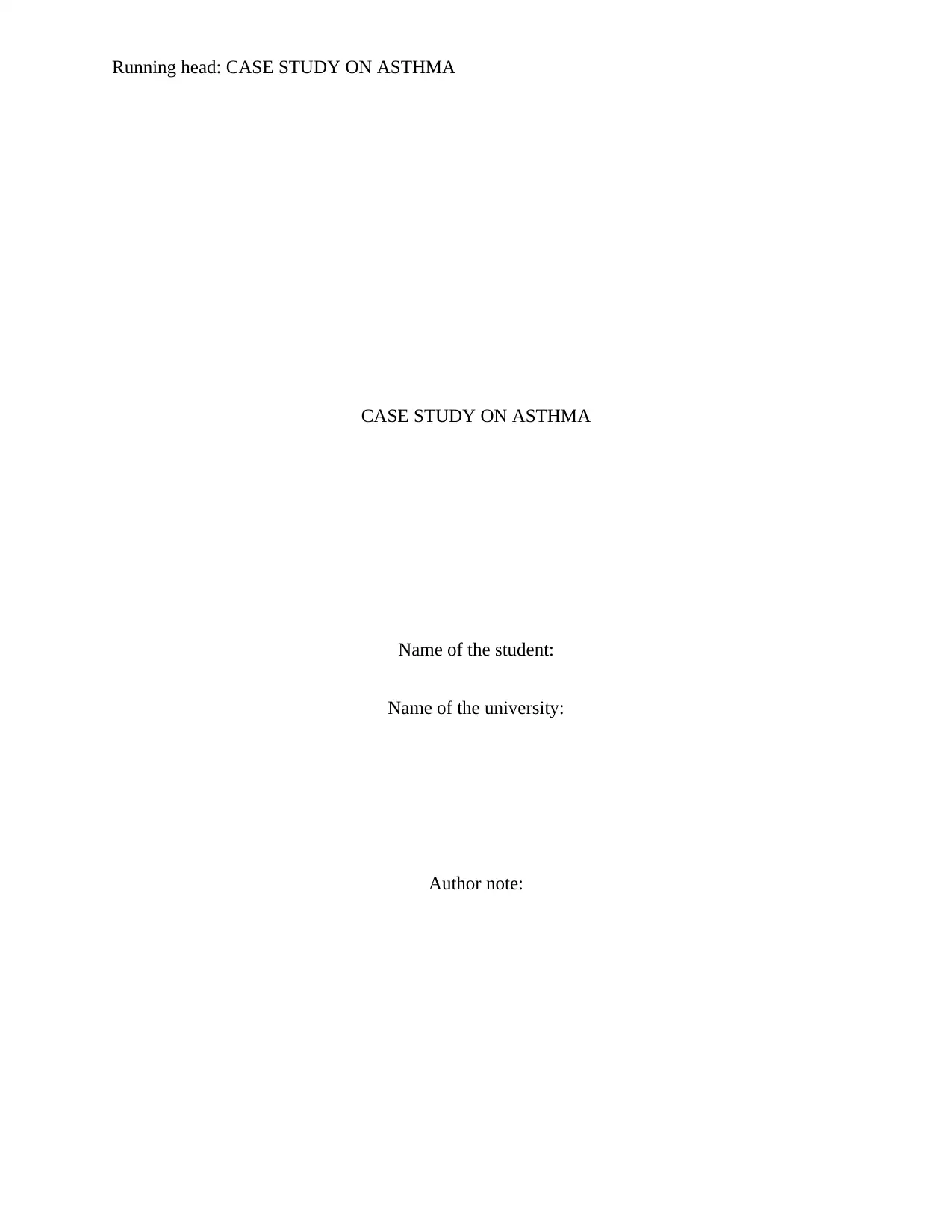
Running head: CASE STUDY ON ASTHMA
CASE STUDY ON ASTHMA
Name of the student:
Name of the university:
Author note:
CASE STUDY ON ASTHMA
Name of the student:
Name of the university:
Author note:
Paraphrase This Document
Need a fresh take? Get an instant paraphrase of this document with our AI Paraphraser
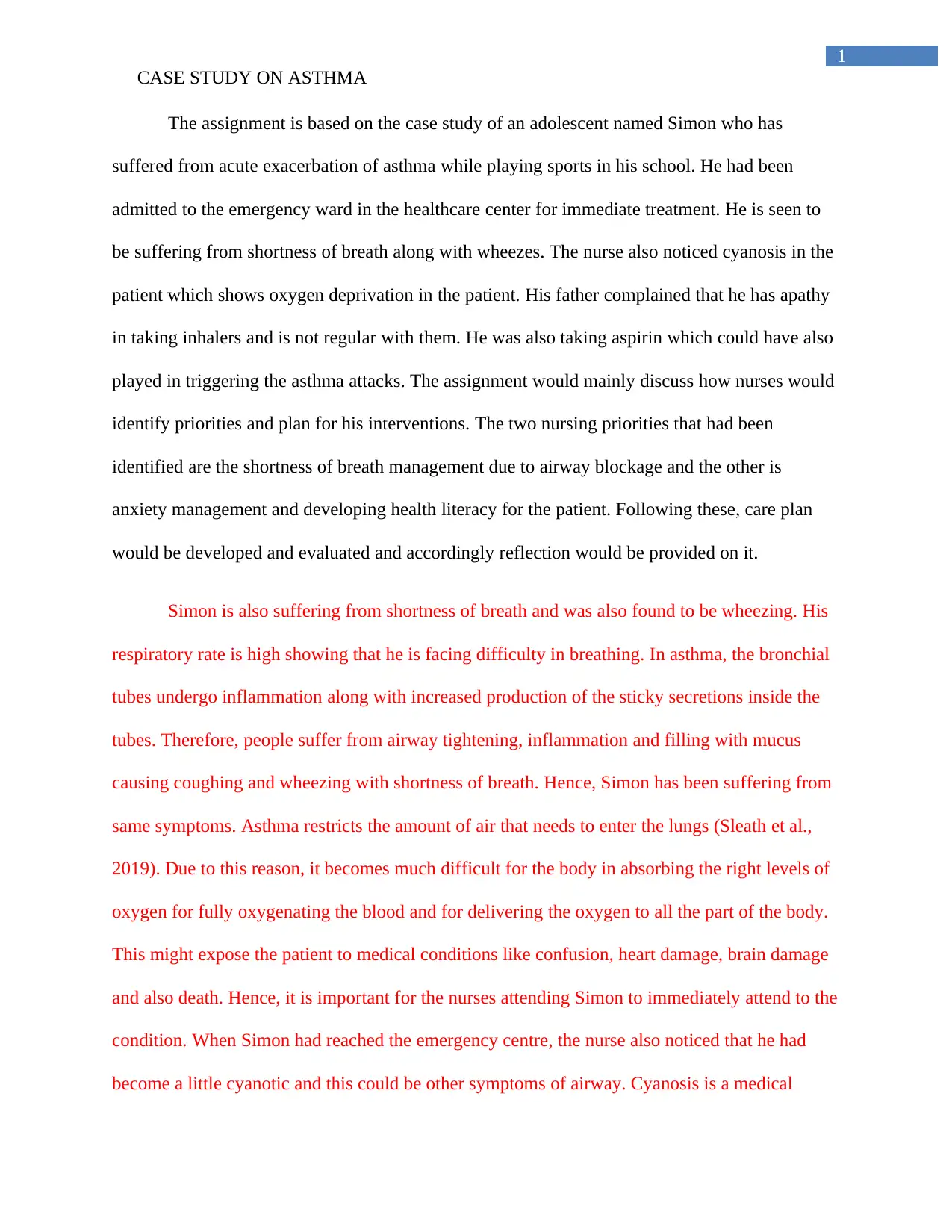
1
CASE STUDY ON ASTHMA
The assignment is based on the case study of an adolescent named Simon who has
suffered from acute exacerbation of asthma while playing sports in his school. He had been
admitted to the emergency ward in the healthcare center for immediate treatment. He is seen to
be suffering from shortness of breath along with wheezes. The nurse also noticed cyanosis in the
patient which shows oxygen deprivation in the patient. His father complained that he has apathy
in taking inhalers and is not regular with them. He was also taking aspirin which could have also
played in triggering the asthma attacks. The assignment would mainly discuss how nurses would
identify priorities and plan for his interventions. The two nursing priorities that had been
identified are the shortness of breath management due to airway blockage and the other is
anxiety management and developing health literacy for the patient. Following these, care plan
would be developed and evaluated and accordingly reflection would be provided on it.
Simon is also suffering from shortness of breath and was also found to be wheezing. His
respiratory rate is high showing that he is facing difficulty in breathing. In asthma, the bronchial
tubes undergo inflammation along with increased production of the sticky secretions inside the
tubes. Therefore, people suffer from airway tightening, inflammation and filling with mucus
causing coughing and wheezing with shortness of breath. Hence, Simon has been suffering from
same symptoms. Asthma restricts the amount of air that needs to enter the lungs (Sleath et al.,
2019). Due to this reason, it becomes much difficult for the body in absorbing the right levels of
oxygen for fully oxygenating the blood and for delivering the oxygen to all the part of the body.
This might expose the patient to medical conditions like confusion, heart damage, brain damage
and also death. Hence, it is important for the nurses attending Simon to immediately attend to the
condition. When Simon had reached the emergency centre, the nurse also noticed that he had
become a little cyanotic and this could be other symptoms of airway. Cyanosis is a medical
CASE STUDY ON ASTHMA
The assignment is based on the case study of an adolescent named Simon who has
suffered from acute exacerbation of asthma while playing sports in his school. He had been
admitted to the emergency ward in the healthcare center for immediate treatment. He is seen to
be suffering from shortness of breath along with wheezes. The nurse also noticed cyanosis in the
patient which shows oxygen deprivation in the patient. His father complained that he has apathy
in taking inhalers and is not regular with them. He was also taking aspirin which could have also
played in triggering the asthma attacks. The assignment would mainly discuss how nurses would
identify priorities and plan for his interventions. The two nursing priorities that had been
identified are the shortness of breath management due to airway blockage and the other is
anxiety management and developing health literacy for the patient. Following these, care plan
would be developed and evaluated and accordingly reflection would be provided on it.
Simon is also suffering from shortness of breath and was also found to be wheezing. His
respiratory rate is high showing that he is facing difficulty in breathing. In asthma, the bronchial
tubes undergo inflammation along with increased production of the sticky secretions inside the
tubes. Therefore, people suffer from airway tightening, inflammation and filling with mucus
causing coughing and wheezing with shortness of breath. Hence, Simon has been suffering from
same symptoms. Asthma restricts the amount of air that needs to enter the lungs (Sleath et al.,
2019). Due to this reason, it becomes much difficult for the body in absorbing the right levels of
oxygen for fully oxygenating the blood and for delivering the oxygen to all the part of the body.
This might expose the patient to medical conditions like confusion, heart damage, brain damage
and also death. Hence, it is important for the nurses attending Simon to immediately attend to the
condition. When Simon had reached the emergency centre, the nurse also noticed that he had
become a little cyanotic and this could be other symptoms of airway. Cyanosis is a medical
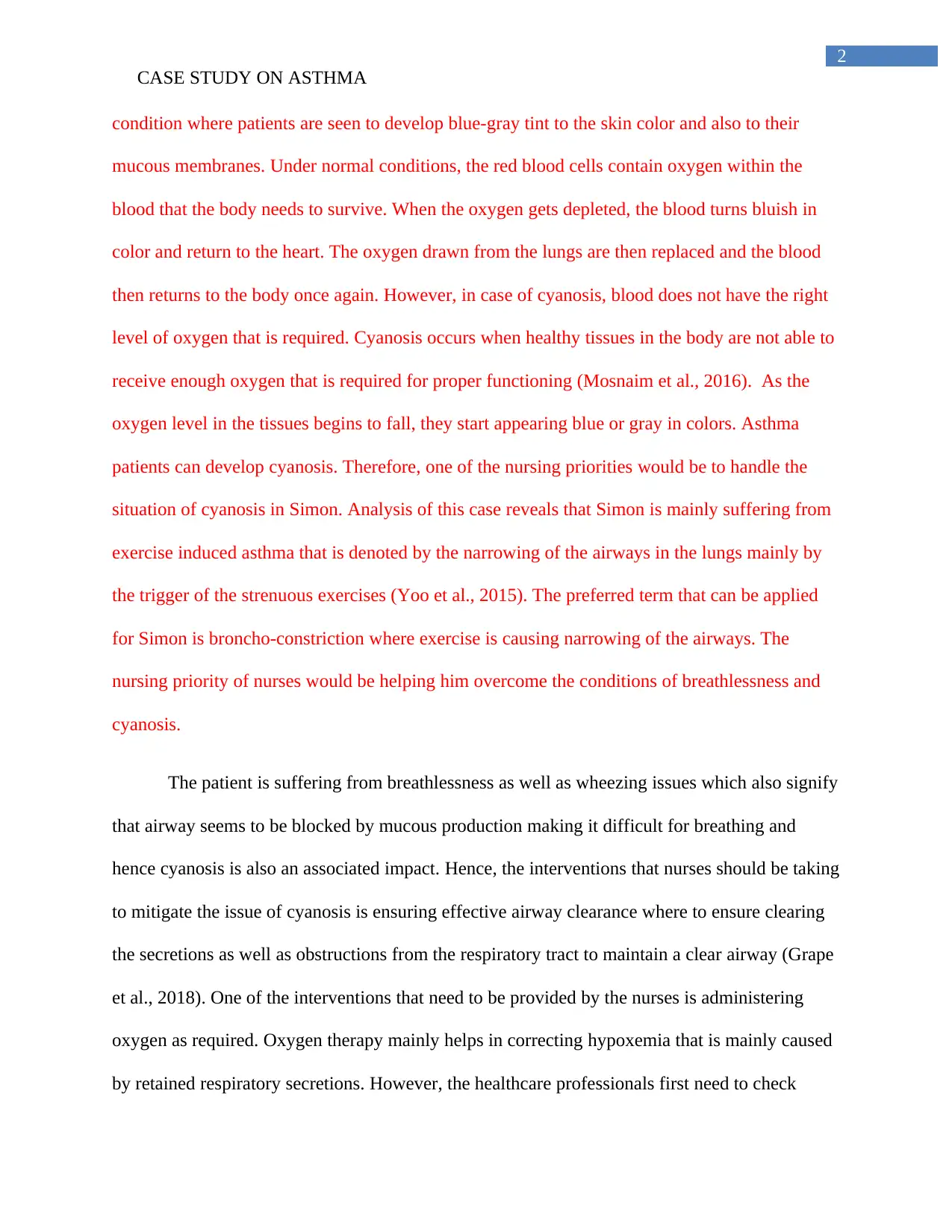
2
CASE STUDY ON ASTHMA
condition where patients are seen to develop blue-gray tint to the skin color and also to their
mucous membranes. Under normal conditions, the red blood cells contain oxygen within the
blood that the body needs to survive. When the oxygen gets depleted, the blood turns bluish in
color and return to the heart. The oxygen drawn from the lungs are then replaced and the blood
then returns to the body once again. However, in case of cyanosis, blood does not have the right
level of oxygen that is required. Cyanosis occurs when healthy tissues in the body are not able to
receive enough oxygen that is required for proper functioning (Mosnaim et al., 2016). As the
oxygen level in the tissues begins to fall, they start appearing blue or gray in colors. Asthma
patients can develop cyanosis. Therefore, one of the nursing priorities would be to handle the
situation of cyanosis in Simon. Analysis of this case reveals that Simon is mainly suffering from
exercise induced asthma that is denoted by the narrowing of the airways in the lungs mainly by
the trigger of the strenuous exercises (Yoo et al., 2015). The preferred term that can be applied
for Simon is broncho-constriction where exercise is causing narrowing of the airways. The
nursing priority of nurses would be helping him overcome the conditions of breathlessness and
cyanosis.
The patient is suffering from breathlessness as well as wheezing issues which also signify
that airway seems to be blocked by mucous production making it difficult for breathing and
hence cyanosis is also an associated impact. Hence, the interventions that nurses should be taking
to mitigate the issue of cyanosis is ensuring effective airway clearance where to ensure clearing
the secretions as well as obstructions from the respiratory tract to maintain a clear airway (Grape
et al., 2018). One of the interventions that need to be provided by the nurses is administering
oxygen as required. Oxygen therapy mainly helps in correcting hypoxemia that is mainly caused
by retained respiratory secretions. However, the healthcare professionals first need to check
CASE STUDY ON ASTHMA
condition where patients are seen to develop blue-gray tint to the skin color and also to their
mucous membranes. Under normal conditions, the red blood cells contain oxygen within the
blood that the body needs to survive. When the oxygen gets depleted, the blood turns bluish in
color and return to the heart. The oxygen drawn from the lungs are then replaced and the blood
then returns to the body once again. However, in case of cyanosis, blood does not have the right
level of oxygen that is required. Cyanosis occurs when healthy tissues in the body are not able to
receive enough oxygen that is required for proper functioning (Mosnaim et al., 2016). As the
oxygen level in the tissues begins to fall, they start appearing blue or gray in colors. Asthma
patients can develop cyanosis. Therefore, one of the nursing priorities would be to handle the
situation of cyanosis in Simon. Analysis of this case reveals that Simon is mainly suffering from
exercise induced asthma that is denoted by the narrowing of the airways in the lungs mainly by
the trigger of the strenuous exercises (Yoo et al., 2015). The preferred term that can be applied
for Simon is broncho-constriction where exercise is causing narrowing of the airways. The
nursing priority of nurses would be helping him overcome the conditions of breathlessness and
cyanosis.
The patient is suffering from breathlessness as well as wheezing issues which also signify
that airway seems to be blocked by mucous production making it difficult for breathing and
hence cyanosis is also an associated impact. Hence, the interventions that nurses should be taking
to mitigate the issue of cyanosis is ensuring effective airway clearance where to ensure clearing
the secretions as well as obstructions from the respiratory tract to maintain a clear airway (Grape
et al., 2018). One of the interventions that need to be provided by the nurses is administering
oxygen as required. Oxygen therapy mainly helps in correcting hypoxemia that is mainly caused
by retained respiratory secretions. However, the healthcare professionals first need to check
⊘ This is a preview!⊘
Do you want full access?
Subscribe today to unlock all pages.

Trusted by 1+ million students worldwide
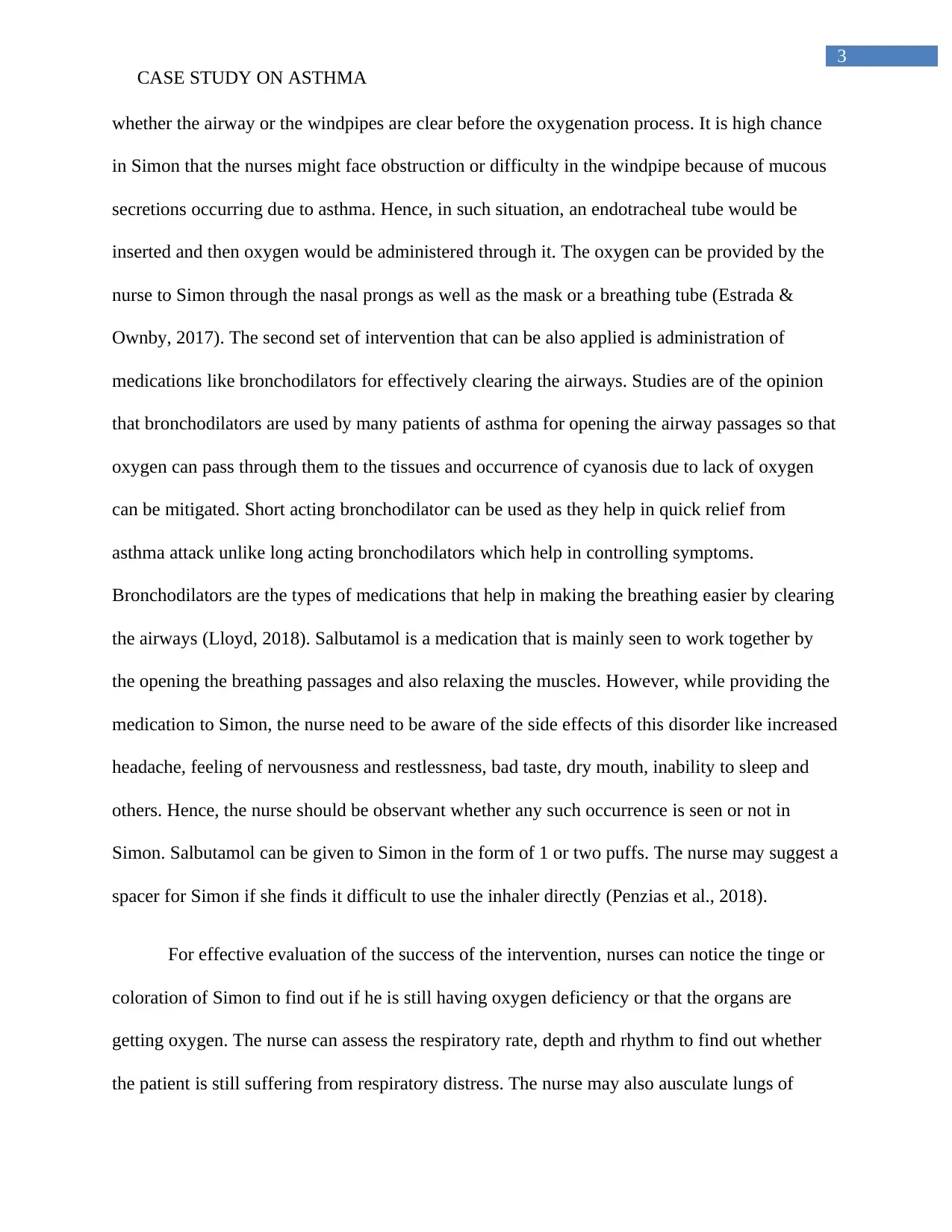
3
CASE STUDY ON ASTHMA
whether the airway or the windpipes are clear before the oxygenation process. It is high chance
in Simon that the nurses might face obstruction or difficulty in the windpipe because of mucous
secretions occurring due to asthma. Hence, in such situation, an endotracheal tube would be
inserted and then oxygen would be administered through it. The oxygen can be provided by the
nurse to Simon through the nasal prongs as well as the mask or a breathing tube (Estrada &
Ownby, 2017). The second set of intervention that can be also applied is administration of
medications like bronchodilators for effectively clearing the airways. Studies are of the opinion
that bronchodilators are used by many patients of asthma for opening the airway passages so that
oxygen can pass through them to the tissues and occurrence of cyanosis due to lack of oxygen
can be mitigated. Short acting bronchodilator can be used as they help in quick relief from
asthma attack unlike long acting bronchodilators which help in controlling symptoms.
Bronchodilators are the types of medications that help in making the breathing easier by clearing
the airways (Lloyd, 2018). Salbutamol is a medication that is mainly seen to work together by
the opening the breathing passages and also relaxing the muscles. However, while providing the
medication to Simon, the nurse need to be aware of the side effects of this disorder like increased
headache, feeling of nervousness and restlessness, bad taste, dry mouth, inability to sleep and
others. Hence, the nurse should be observant whether any such occurrence is seen or not in
Simon. Salbutamol can be given to Simon in the form of 1 or two puffs. The nurse may suggest a
spacer for Simon if she finds it difficult to use the inhaler directly (Penzias et al., 2018).
For effective evaluation of the success of the intervention, nurses can notice the tinge or
coloration of Simon to find out if he is still having oxygen deficiency or that the organs are
getting oxygen. The nurse can assess the respiratory rate, depth and rhythm to find out whether
the patient is still suffering from respiratory distress. The nurse may also ausculate lungs of
CASE STUDY ON ASTHMA
whether the airway or the windpipes are clear before the oxygenation process. It is high chance
in Simon that the nurses might face obstruction or difficulty in the windpipe because of mucous
secretions occurring due to asthma. Hence, in such situation, an endotracheal tube would be
inserted and then oxygen would be administered through it. The oxygen can be provided by the
nurse to Simon through the nasal prongs as well as the mask or a breathing tube (Estrada &
Ownby, 2017). The second set of intervention that can be also applied is administration of
medications like bronchodilators for effectively clearing the airways. Studies are of the opinion
that bronchodilators are used by many patients of asthma for opening the airway passages so that
oxygen can pass through them to the tissues and occurrence of cyanosis due to lack of oxygen
can be mitigated. Short acting bronchodilator can be used as they help in quick relief from
asthma attack unlike long acting bronchodilators which help in controlling symptoms.
Bronchodilators are the types of medications that help in making the breathing easier by clearing
the airways (Lloyd, 2018). Salbutamol is a medication that is mainly seen to work together by
the opening the breathing passages and also relaxing the muscles. However, while providing the
medication to Simon, the nurse need to be aware of the side effects of this disorder like increased
headache, feeling of nervousness and restlessness, bad taste, dry mouth, inability to sleep and
others. Hence, the nurse should be observant whether any such occurrence is seen or not in
Simon. Salbutamol can be given to Simon in the form of 1 or two puffs. The nurse may suggest a
spacer for Simon if she finds it difficult to use the inhaler directly (Penzias et al., 2018).
For effective evaluation of the success of the intervention, nurses can notice the tinge or
coloration of Simon to find out if he is still having oxygen deficiency or that the organs are
getting oxygen. The nurse can assess the respiratory rate, depth and rhythm to find out whether
the patient is still suffering from respiratory distress. The nurse may also ausculate lungs of
Paraphrase This Document
Need a fresh take? Get an instant paraphrase of this document with our AI Paraphraser
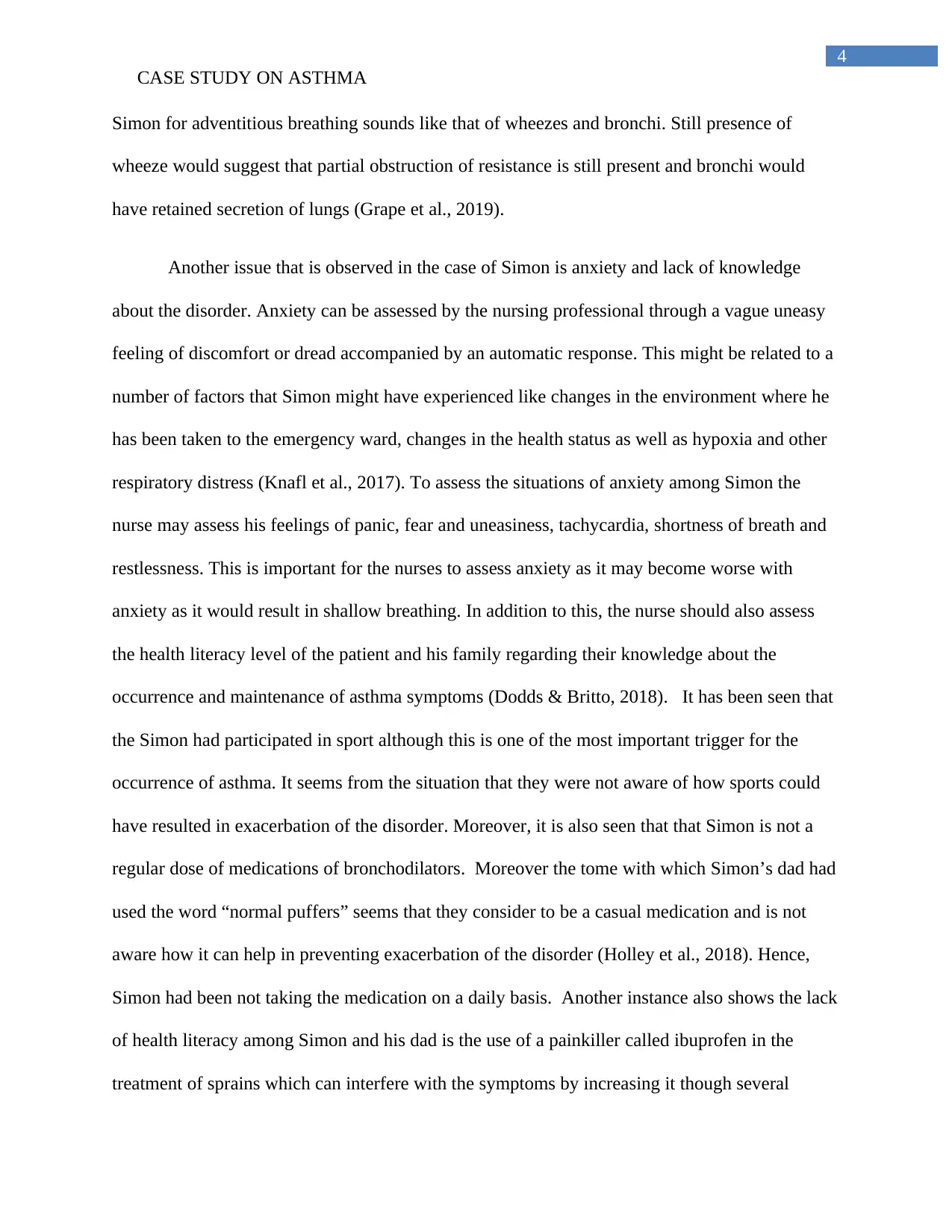
4
CASE STUDY ON ASTHMA
Simon for adventitious breathing sounds like that of wheezes and bronchi. Still presence of
wheeze would suggest that partial obstruction of resistance is still present and bronchi would
have retained secretion of lungs (Grape et al., 2019).
Another issue that is observed in the case of Simon is anxiety and lack of knowledge
about the disorder. Anxiety can be assessed by the nursing professional through a vague uneasy
feeling of discomfort or dread accompanied by an automatic response. This might be related to a
number of factors that Simon might have experienced like changes in the environment where he
has been taken to the emergency ward, changes in the health status as well as hypoxia and other
respiratory distress (Knafl et al., 2017). To assess the situations of anxiety among Simon the
nurse may assess his feelings of panic, fear and uneasiness, tachycardia, shortness of breath and
restlessness. This is important for the nurses to assess anxiety as it may become worse with
anxiety as it would result in shallow breathing. In addition to this, the nurse should also assess
the health literacy level of the patient and his family regarding their knowledge about the
occurrence and maintenance of asthma symptoms (Dodds & Britto, 2018). It has been seen that
the Simon had participated in sport although this is one of the most important trigger for the
occurrence of asthma. It seems from the situation that they were not aware of how sports could
have resulted in exacerbation of the disorder. Moreover, it is also seen that that Simon is not a
regular dose of medications of bronchodilators. Moreover the tome with which Simon’s dad had
used the word “normal puffers” seems that they consider to be a casual medication and is not
aware how it can help in preventing exacerbation of the disorder (Holley et al., 2018). Hence,
Simon had been not taking the medication on a daily basis. Another instance also shows the lack
of health literacy among Simon and his dad is the use of a painkiller called ibuprofen in the
treatment of sprains which can interfere with the symptoms by increasing it though several
CASE STUDY ON ASTHMA
Simon for adventitious breathing sounds like that of wheezes and bronchi. Still presence of
wheeze would suggest that partial obstruction of resistance is still present and bronchi would
have retained secretion of lungs (Grape et al., 2019).
Another issue that is observed in the case of Simon is anxiety and lack of knowledge
about the disorder. Anxiety can be assessed by the nursing professional through a vague uneasy
feeling of discomfort or dread accompanied by an automatic response. This might be related to a
number of factors that Simon might have experienced like changes in the environment where he
has been taken to the emergency ward, changes in the health status as well as hypoxia and other
respiratory distress (Knafl et al., 2017). To assess the situations of anxiety among Simon the
nurse may assess his feelings of panic, fear and uneasiness, tachycardia, shortness of breath and
restlessness. This is important for the nurses to assess anxiety as it may become worse with
anxiety as it would result in shallow breathing. In addition to this, the nurse should also assess
the health literacy level of the patient and his family regarding their knowledge about the
occurrence and maintenance of asthma symptoms (Dodds & Britto, 2018). It has been seen that
the Simon had participated in sport although this is one of the most important trigger for the
occurrence of asthma. It seems from the situation that they were not aware of how sports could
have resulted in exacerbation of the disorder. Moreover, it is also seen that that Simon is not a
regular dose of medications of bronchodilators. Moreover the tome with which Simon’s dad had
used the word “normal puffers” seems that they consider to be a casual medication and is not
aware how it can help in preventing exacerbation of the disorder (Holley et al., 2018). Hence,
Simon had been not taking the medication on a daily basis. Another instance also shows the lack
of health literacy among Simon and his dad is the use of a painkiller called ibuprofen in the
treatment of sprains which can interfere with the symptoms by increasing it though several
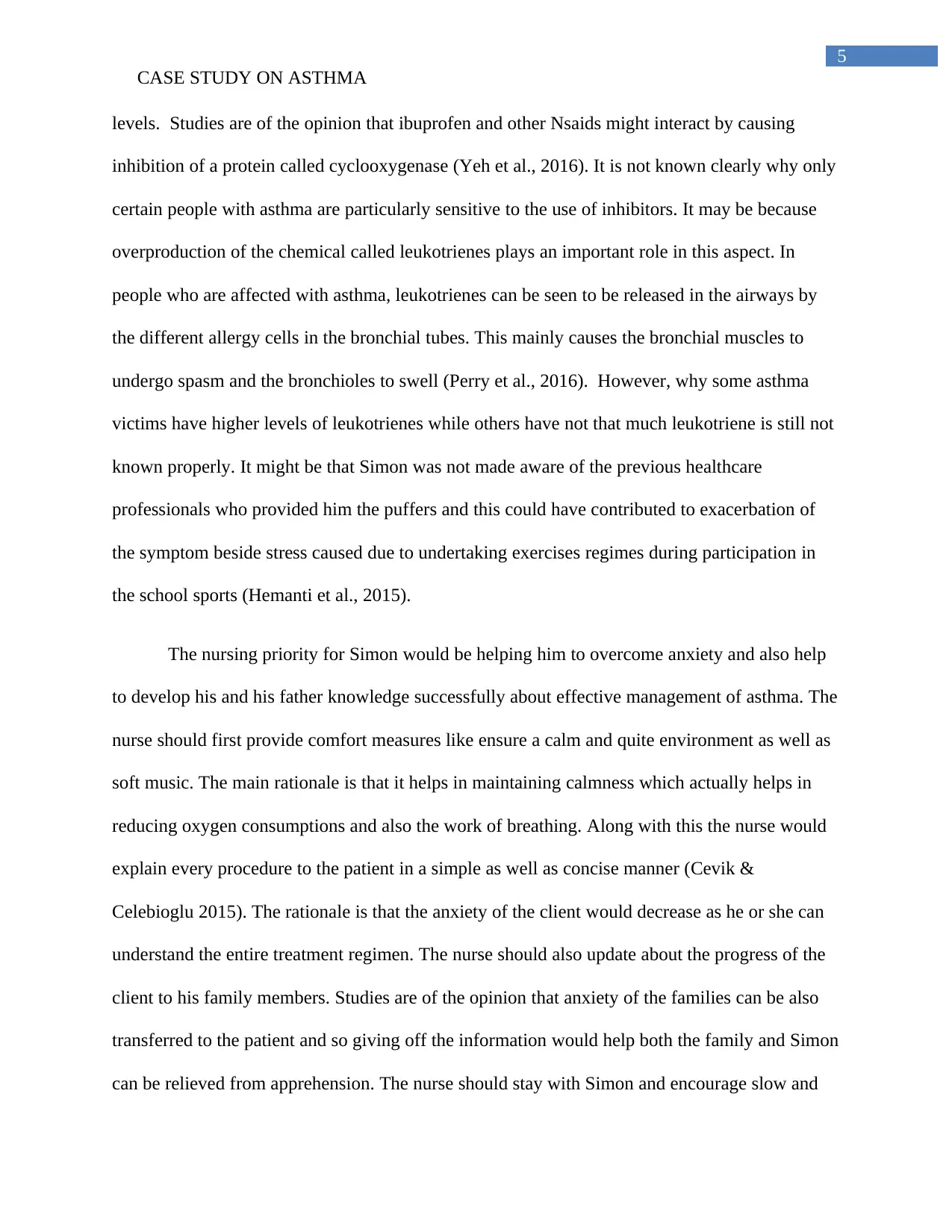
5
CASE STUDY ON ASTHMA
levels. Studies are of the opinion that ibuprofen and other Nsaids might interact by causing
inhibition of a protein called cyclooxygenase (Yeh et al., 2016). It is not known clearly why only
certain people with asthma are particularly sensitive to the use of inhibitors. It may be because
overproduction of the chemical called leukotrienes plays an important role in this aspect. In
people who are affected with asthma, leukotrienes can be seen to be released in the airways by
the different allergy cells in the bronchial tubes. This mainly causes the bronchial muscles to
undergo spasm and the bronchioles to swell (Perry et al., 2016). However, why some asthma
victims have higher levels of leukotrienes while others have not that much leukotriene is still not
known properly. It might be that Simon was not made aware of the previous healthcare
professionals who provided him the puffers and this could have contributed to exacerbation of
the symptom beside stress caused due to undertaking exercises regimes during participation in
the school sports (Hemanti et al., 2015).
The nursing priority for Simon would be helping him to overcome anxiety and also help
to develop his and his father knowledge successfully about effective management of asthma. The
nurse should first provide comfort measures like ensure a calm and quite environment as well as
soft music. The main rationale is that it helps in maintaining calmness which actually helps in
reducing oxygen consumptions and also the work of breathing. Along with this the nurse would
explain every procedure to the patient in a simple as well as concise manner (Cevik &
Celebioglu 2015). The rationale is that the anxiety of the client would decrease as he or she can
understand the entire treatment regimen. The nurse should also update about the progress of the
client to his family members. Studies are of the opinion that anxiety of the families can be also
transferred to the patient and so giving off the information would help both the family and Simon
can be relieved from apprehension. The nurse should stay with Simon and encourage slow and
CASE STUDY ON ASTHMA
levels. Studies are of the opinion that ibuprofen and other Nsaids might interact by causing
inhibition of a protein called cyclooxygenase (Yeh et al., 2016). It is not known clearly why only
certain people with asthma are particularly sensitive to the use of inhibitors. It may be because
overproduction of the chemical called leukotrienes plays an important role in this aspect. In
people who are affected with asthma, leukotrienes can be seen to be released in the airways by
the different allergy cells in the bronchial tubes. This mainly causes the bronchial muscles to
undergo spasm and the bronchioles to swell (Perry et al., 2016). However, why some asthma
victims have higher levels of leukotrienes while others have not that much leukotriene is still not
known properly. It might be that Simon was not made aware of the previous healthcare
professionals who provided him the puffers and this could have contributed to exacerbation of
the symptom beside stress caused due to undertaking exercises regimes during participation in
the school sports (Hemanti et al., 2015).
The nursing priority for Simon would be helping him to overcome anxiety and also help
to develop his and his father knowledge successfully about effective management of asthma. The
nurse should first provide comfort measures like ensure a calm and quite environment as well as
soft music. The main rationale is that it helps in maintaining calmness which actually helps in
reducing oxygen consumptions and also the work of breathing. Along with this the nurse would
explain every procedure to the patient in a simple as well as concise manner (Cevik &
Celebioglu 2015). The rationale is that the anxiety of the client would decrease as he or she can
understand the entire treatment regimen. The nurse should also update about the progress of the
client to his family members. Studies are of the opinion that anxiety of the families can be also
transferred to the patient and so giving off the information would help both the family and Simon
can be relieved from apprehension. The nurse should stay with Simon and encourage slow and
⊘ This is a preview!⊘
Do you want full access?
Subscribe today to unlock all pages.

Trusted by 1+ million students worldwide
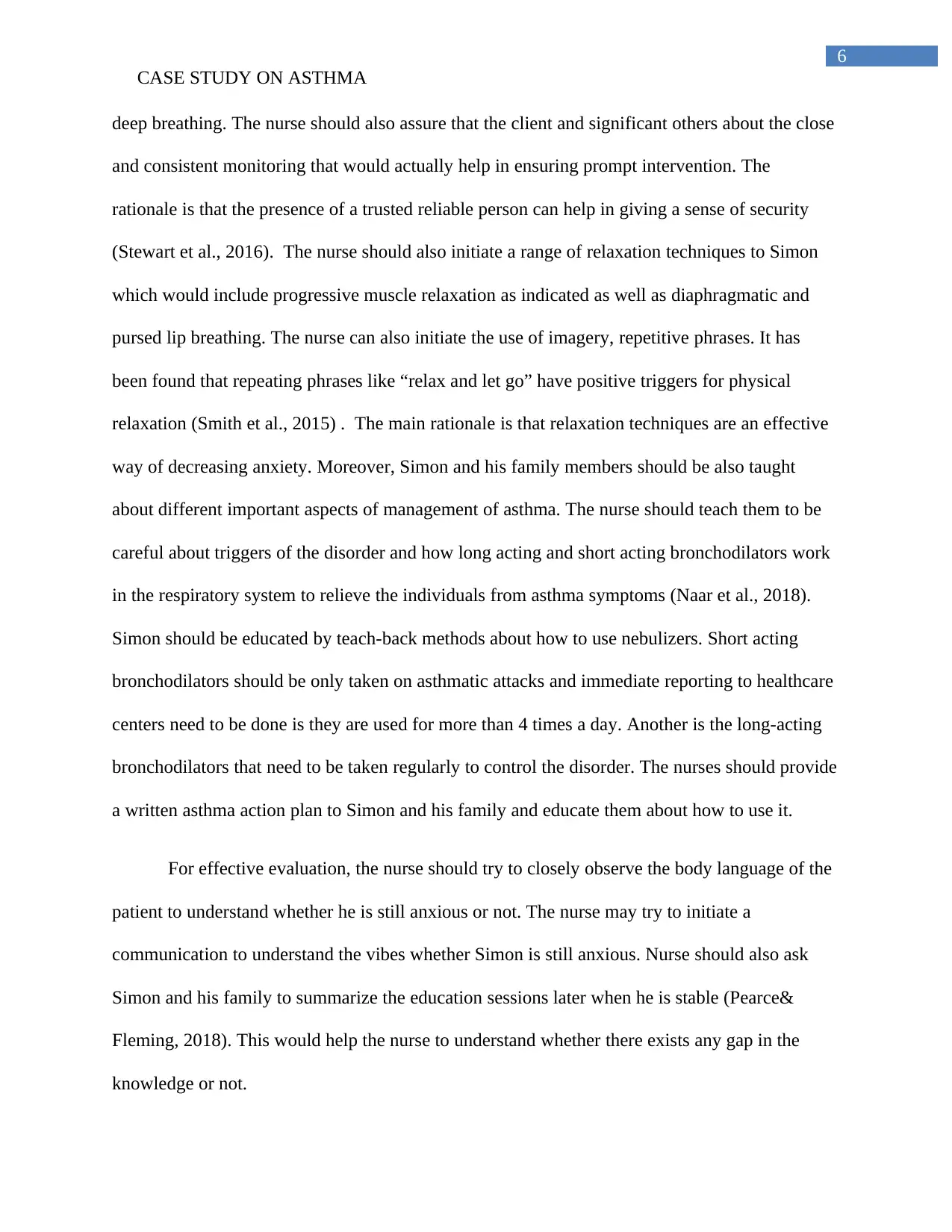
6
CASE STUDY ON ASTHMA
deep breathing. The nurse should also assure that the client and significant others about the close
and consistent monitoring that would actually help in ensuring prompt intervention. The
rationale is that the presence of a trusted reliable person can help in giving a sense of security
(Stewart et al., 2016). The nurse should also initiate a range of relaxation techniques to Simon
which would include progressive muscle relaxation as indicated as well as diaphragmatic and
pursed lip breathing. The nurse can also initiate the use of imagery, repetitive phrases. It has
been found that repeating phrases like “relax and let go” have positive triggers for physical
relaxation (Smith et al., 2015) . The main rationale is that relaxation techniques are an effective
way of decreasing anxiety. Moreover, Simon and his family members should be also taught
about different important aspects of management of asthma. The nurse should teach them to be
careful about triggers of the disorder and how long acting and short acting bronchodilators work
in the respiratory system to relieve the individuals from asthma symptoms (Naar et al., 2018).
Simon should be educated by teach-back methods about how to use nebulizers. Short acting
bronchodilators should be only taken on asthmatic attacks and immediate reporting to healthcare
centers need to be done is they are used for more than 4 times a day. Another is the long-acting
bronchodilators that need to be taken regularly to control the disorder. The nurses should provide
a written asthma action plan to Simon and his family and educate them about how to use it.
For effective evaluation, the nurse should try to closely observe the body language of the
patient to understand whether he is still anxious or not. The nurse may try to initiate a
communication to understand the vibes whether Simon is still anxious. Nurse should also ask
Simon and his family to summarize the education sessions later when he is stable (Pearce&
Fleming, 2018). This would help the nurse to understand whether there exists any gap in the
knowledge or not.
CASE STUDY ON ASTHMA
deep breathing. The nurse should also assure that the client and significant others about the close
and consistent monitoring that would actually help in ensuring prompt intervention. The
rationale is that the presence of a trusted reliable person can help in giving a sense of security
(Stewart et al., 2016). The nurse should also initiate a range of relaxation techniques to Simon
which would include progressive muscle relaxation as indicated as well as diaphragmatic and
pursed lip breathing. The nurse can also initiate the use of imagery, repetitive phrases. It has
been found that repeating phrases like “relax and let go” have positive triggers for physical
relaxation (Smith et al., 2015) . The main rationale is that relaxation techniques are an effective
way of decreasing anxiety. Moreover, Simon and his family members should be also taught
about different important aspects of management of asthma. The nurse should teach them to be
careful about triggers of the disorder and how long acting and short acting bronchodilators work
in the respiratory system to relieve the individuals from asthma symptoms (Naar et al., 2018).
Simon should be educated by teach-back methods about how to use nebulizers. Short acting
bronchodilators should be only taken on asthmatic attacks and immediate reporting to healthcare
centers need to be done is they are used for more than 4 times a day. Another is the long-acting
bronchodilators that need to be taken regularly to control the disorder. The nurses should provide
a written asthma action plan to Simon and his family and educate them about how to use it.
For effective evaluation, the nurse should try to closely observe the body language of the
patient to understand whether he is still anxious or not. The nurse may try to initiate a
communication to understand the vibes whether Simon is still anxious. Nurse should also ask
Simon and his family to summarize the education sessions later when he is stable (Pearce&
Fleming, 2018). This would help the nurse to understand whether there exists any gap in the
knowledge or not.
Paraphrase This Document
Need a fresh take? Get an instant paraphrase of this document with our AI Paraphraser
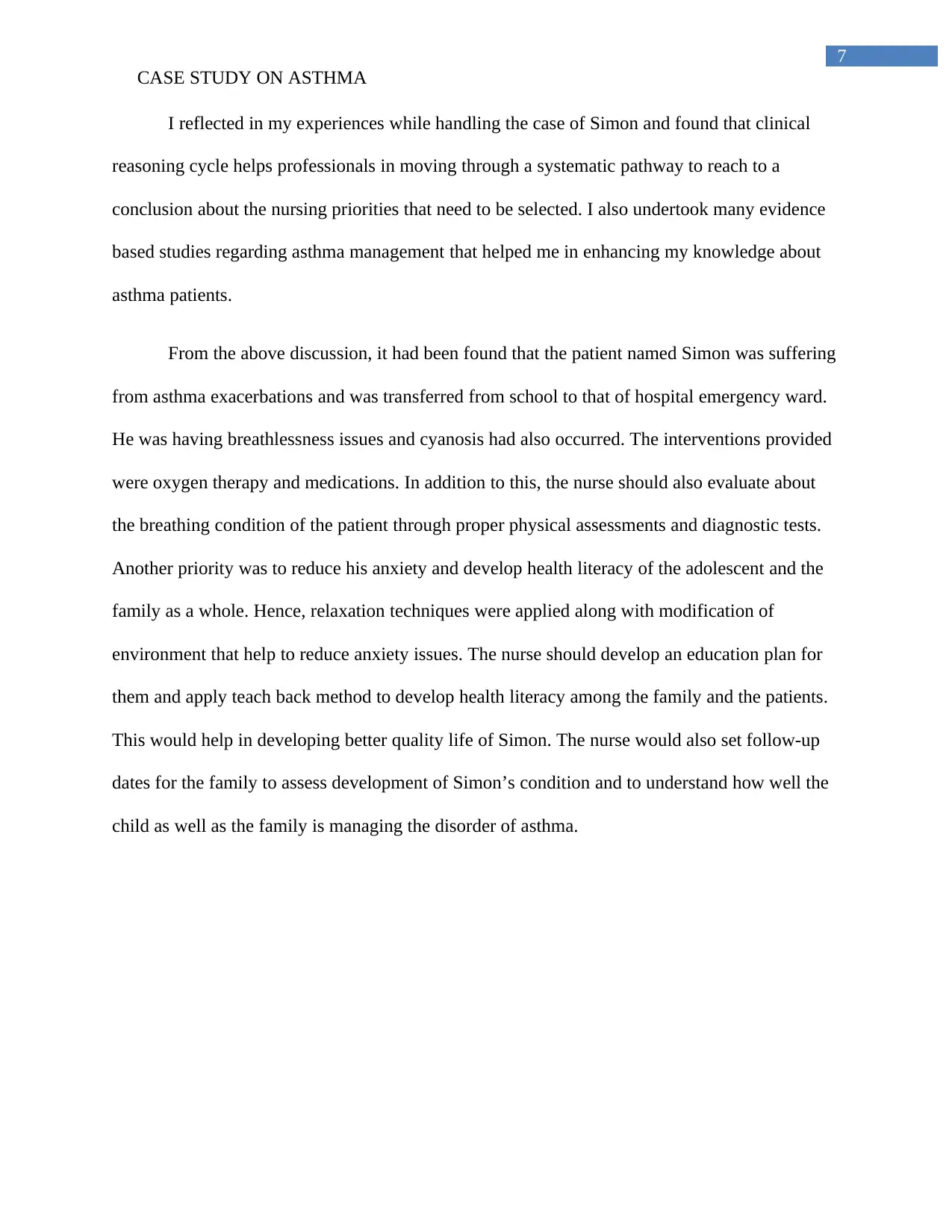
7
CASE STUDY ON ASTHMA
I reflected in my experiences while handling the case of Simon and found that clinical
reasoning cycle helps professionals in moving through a systematic pathway to reach to a
conclusion about the nursing priorities that need to be selected. I also undertook many evidence
based studies regarding asthma management that helped me in enhancing my knowledge about
asthma patients.
From the above discussion, it had been found that the patient named Simon was suffering
from asthma exacerbations and was transferred from school to that of hospital emergency ward.
He was having breathlessness issues and cyanosis had also occurred. The interventions provided
were oxygen therapy and medications. In addition to this, the nurse should also evaluate about
the breathing condition of the patient through proper physical assessments and diagnostic tests.
Another priority was to reduce his anxiety and develop health literacy of the adolescent and the
family as a whole. Hence, relaxation techniques were applied along with modification of
environment that help to reduce anxiety issues. The nurse should develop an education plan for
them and apply teach back method to develop health literacy among the family and the patients.
This would help in developing better quality life of Simon. The nurse would also set follow-up
dates for the family to assess development of Simon’s condition and to understand how well the
child as well as the family is managing the disorder of asthma.
CASE STUDY ON ASTHMA
I reflected in my experiences while handling the case of Simon and found that clinical
reasoning cycle helps professionals in moving through a systematic pathway to reach to a
conclusion about the nursing priorities that need to be selected. I also undertook many evidence
based studies regarding asthma management that helped me in enhancing my knowledge about
asthma patients.
From the above discussion, it had been found that the patient named Simon was suffering
from asthma exacerbations and was transferred from school to that of hospital emergency ward.
He was having breathlessness issues and cyanosis had also occurred. The interventions provided
were oxygen therapy and medications. In addition to this, the nurse should also evaluate about
the breathing condition of the patient through proper physical assessments and diagnostic tests.
Another priority was to reduce his anxiety and develop health literacy of the adolescent and the
family as a whole. Hence, relaxation techniques were applied along with modification of
environment that help to reduce anxiety issues. The nurse should develop an education plan for
them and apply teach back method to develop health literacy among the family and the patients.
This would help in developing better quality life of Simon. The nurse would also set follow-up
dates for the family to assess development of Simon’s condition and to understand how well the
child as well as the family is managing the disorder of asthma.
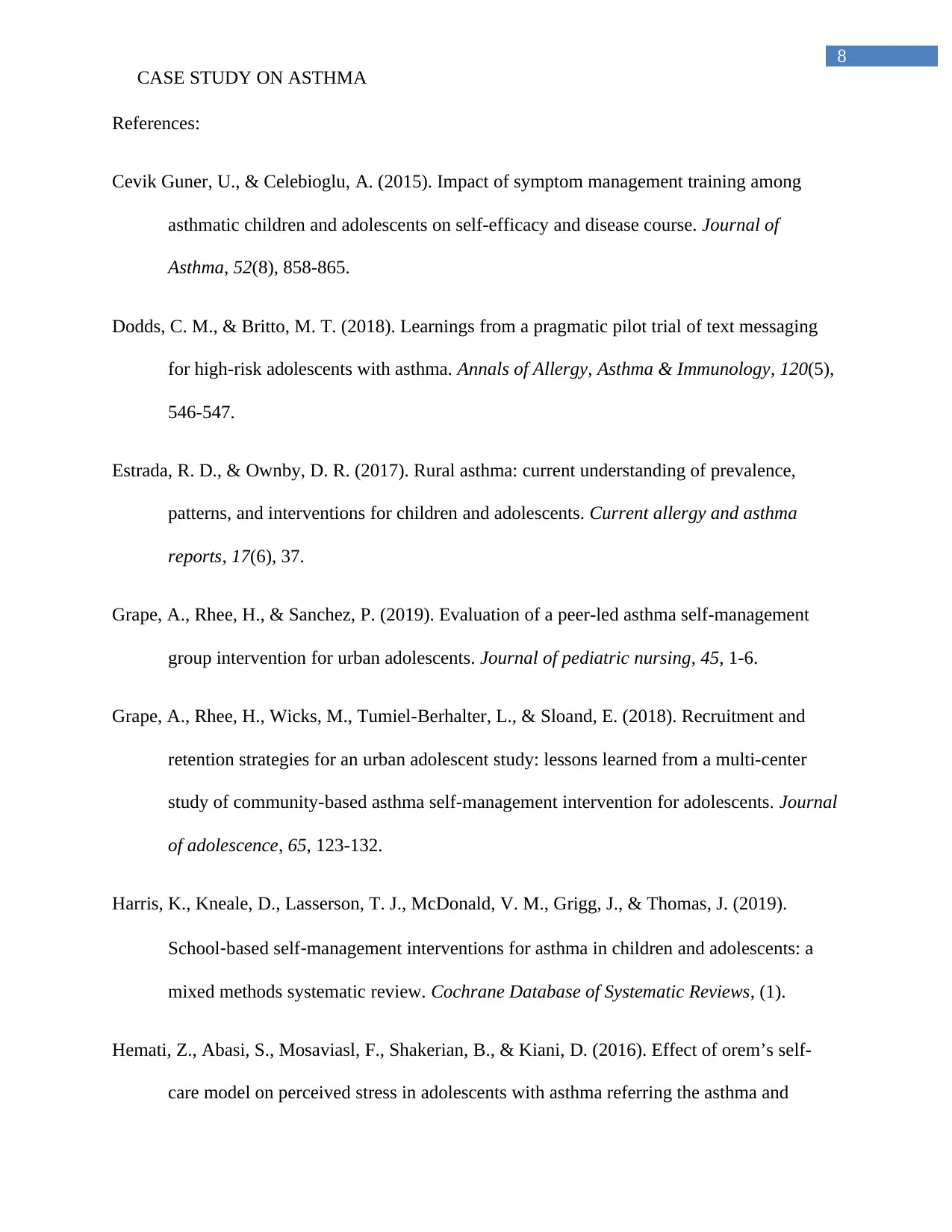
8
CASE STUDY ON ASTHMA
References:
Cevik Guner, U., & Celebioglu, A. (2015). Impact of symptom management training among
asthmatic children and adolescents on self-efficacy and disease course. Journal of
Asthma, 52(8), 858-865.
Dodds, C. M., & Britto, M. T. (2018). Learnings from a pragmatic pilot trial of text messaging
for high-risk adolescents with asthma. Annals of Allergy, Asthma & Immunology, 120(5),
546-547.
Estrada, R. D., & Ownby, D. R. (2017). Rural asthma: current understanding of prevalence,
patterns, and interventions for children and adolescents. Current allergy and asthma
reports, 17(6), 37.
Grape, A., Rhee, H., & Sanchez, P. (2019). Evaluation of a peer-led asthma self-management
group intervention for urban adolescents. Journal of pediatric nursing, 45, 1-6.
Grape, A., Rhee, H., Wicks, M., Tumiel-Berhalter, L., & Sloand, E. (2018). Recruitment and
retention strategies for an urban adolescent study: lessons learned from a multi-center
study of community-based asthma self-management intervention for adolescents. Journal
of adolescence, 65, 123-132.
Harris, K., Kneale, D., Lasserson, T. J., McDonald, V. M., Grigg, J., & Thomas, J. (2019).
School‐based self‐management interventions for asthma in children and adolescents: a
mixed methods systematic review. Cochrane Database of Systematic Reviews, (1).
Hemati, Z., Abasi, S., Mosaviasl, F., Shakerian, B., & Kiani, D. (2016). Effect of orem’s self-
care model on perceived stress in adolescents with asthma referring the asthma and
CASE STUDY ON ASTHMA
References:
Cevik Guner, U., & Celebioglu, A. (2015). Impact of symptom management training among
asthmatic children and adolescents on self-efficacy and disease course. Journal of
Asthma, 52(8), 858-865.
Dodds, C. M., & Britto, M. T. (2018). Learnings from a pragmatic pilot trial of text messaging
for high-risk adolescents with asthma. Annals of Allergy, Asthma & Immunology, 120(5),
546-547.
Estrada, R. D., & Ownby, D. R. (2017). Rural asthma: current understanding of prevalence,
patterns, and interventions for children and adolescents. Current allergy and asthma
reports, 17(6), 37.
Grape, A., Rhee, H., & Sanchez, P. (2019). Evaluation of a peer-led asthma self-management
group intervention for urban adolescents. Journal of pediatric nursing, 45, 1-6.
Grape, A., Rhee, H., Wicks, M., Tumiel-Berhalter, L., & Sloand, E. (2018). Recruitment and
retention strategies for an urban adolescent study: lessons learned from a multi-center
study of community-based asthma self-management intervention for adolescents. Journal
of adolescence, 65, 123-132.
Harris, K., Kneale, D., Lasserson, T. J., McDonald, V. M., Grigg, J., & Thomas, J. (2019).
School‐based self‐management interventions for asthma in children and adolescents: a
mixed methods systematic review. Cochrane Database of Systematic Reviews, (1).
Hemati, Z., Abasi, S., Mosaviasl, F., Shakerian, B., & Kiani, D. (2016). Effect of orem’s self-
care model on perceived stress in adolescents with asthma referring the asthma and
⊘ This is a preview!⊘
Do you want full access?
Subscribe today to unlock all pages.

Trusted by 1+ million students worldwide
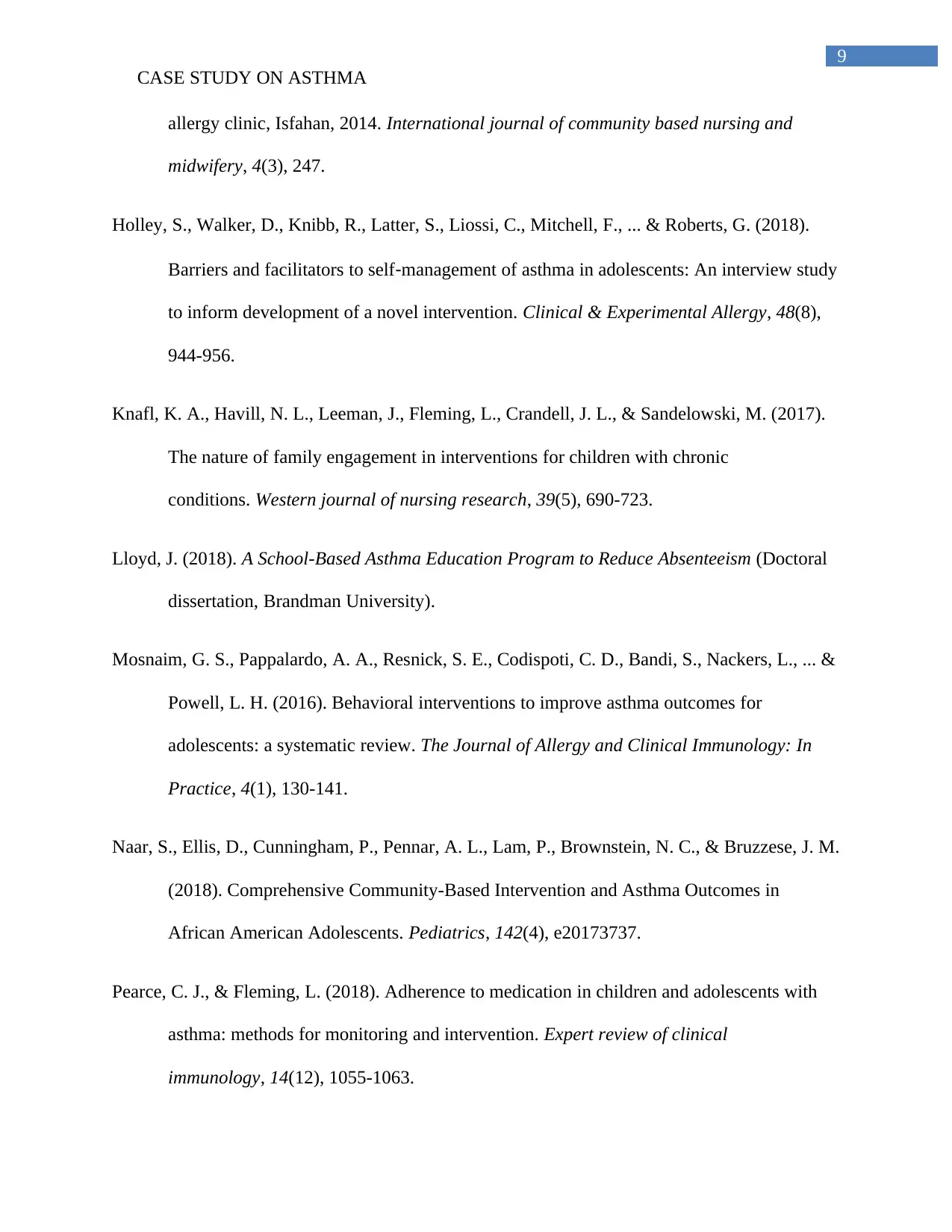
9
CASE STUDY ON ASTHMA
allergy clinic, Isfahan, 2014. International journal of community based nursing and
midwifery, 4(3), 247.
Holley, S., Walker, D., Knibb, R., Latter, S., Liossi, C., Mitchell, F., ... & Roberts, G. (2018).
Barriers and facilitators to self‐management of asthma in adolescents: An interview study
to inform development of a novel intervention. Clinical & Experimental Allergy, 48(8),
944-956.
Knafl, K. A., Havill, N. L., Leeman, J., Fleming, L., Crandell, J. L., & Sandelowski, M. (2017).
The nature of family engagement in interventions for children with chronic
conditions. Western journal of nursing research, 39(5), 690-723.
Lloyd, J. (2018). A School-Based Asthma Education Program to Reduce Absenteeism (Doctoral
dissertation, Brandman University).
Mosnaim, G. S., Pappalardo, A. A., Resnick, S. E., Codispoti, C. D., Bandi, S., Nackers, L., ... &
Powell, L. H. (2016). Behavioral interventions to improve asthma outcomes for
adolescents: a systematic review. The Journal of Allergy and Clinical Immunology: In
Practice, 4(1), 130-141.
Naar, S., Ellis, D., Cunningham, P., Pennar, A. L., Lam, P., Brownstein, N. C., & Bruzzese, J. M.
(2018). Comprehensive Community-Based Intervention and Asthma Outcomes in
African American Adolescents. Pediatrics, 142(4), e20173737.
Pearce, C. J., & Fleming, L. (2018). Adherence to medication in children and adolescents with
asthma: methods for monitoring and intervention. Expert review of clinical
immunology, 14(12), 1055-1063.
CASE STUDY ON ASTHMA
allergy clinic, Isfahan, 2014. International journal of community based nursing and
midwifery, 4(3), 247.
Holley, S., Walker, D., Knibb, R., Latter, S., Liossi, C., Mitchell, F., ... & Roberts, G. (2018).
Barriers and facilitators to self‐management of asthma in adolescents: An interview study
to inform development of a novel intervention. Clinical & Experimental Allergy, 48(8),
944-956.
Knafl, K. A., Havill, N. L., Leeman, J., Fleming, L., Crandell, J. L., & Sandelowski, M. (2017).
The nature of family engagement in interventions for children with chronic
conditions. Western journal of nursing research, 39(5), 690-723.
Lloyd, J. (2018). A School-Based Asthma Education Program to Reduce Absenteeism (Doctoral
dissertation, Brandman University).
Mosnaim, G. S., Pappalardo, A. A., Resnick, S. E., Codispoti, C. D., Bandi, S., Nackers, L., ... &
Powell, L. H. (2016). Behavioral interventions to improve asthma outcomes for
adolescents: a systematic review. The Journal of Allergy and Clinical Immunology: In
Practice, 4(1), 130-141.
Naar, S., Ellis, D., Cunningham, P., Pennar, A. L., Lam, P., Brownstein, N. C., & Bruzzese, J. M.
(2018). Comprehensive Community-Based Intervention and Asthma Outcomes in
African American Adolescents. Pediatrics, 142(4), e20173737.
Pearce, C. J., & Fleming, L. (2018). Adherence to medication in children and adolescents with
asthma: methods for monitoring and intervention. Expert review of clinical
immunology, 14(12), 1055-1063.
Paraphrase This Document
Need a fresh take? Get an instant paraphrase of this document with our AI Paraphraser
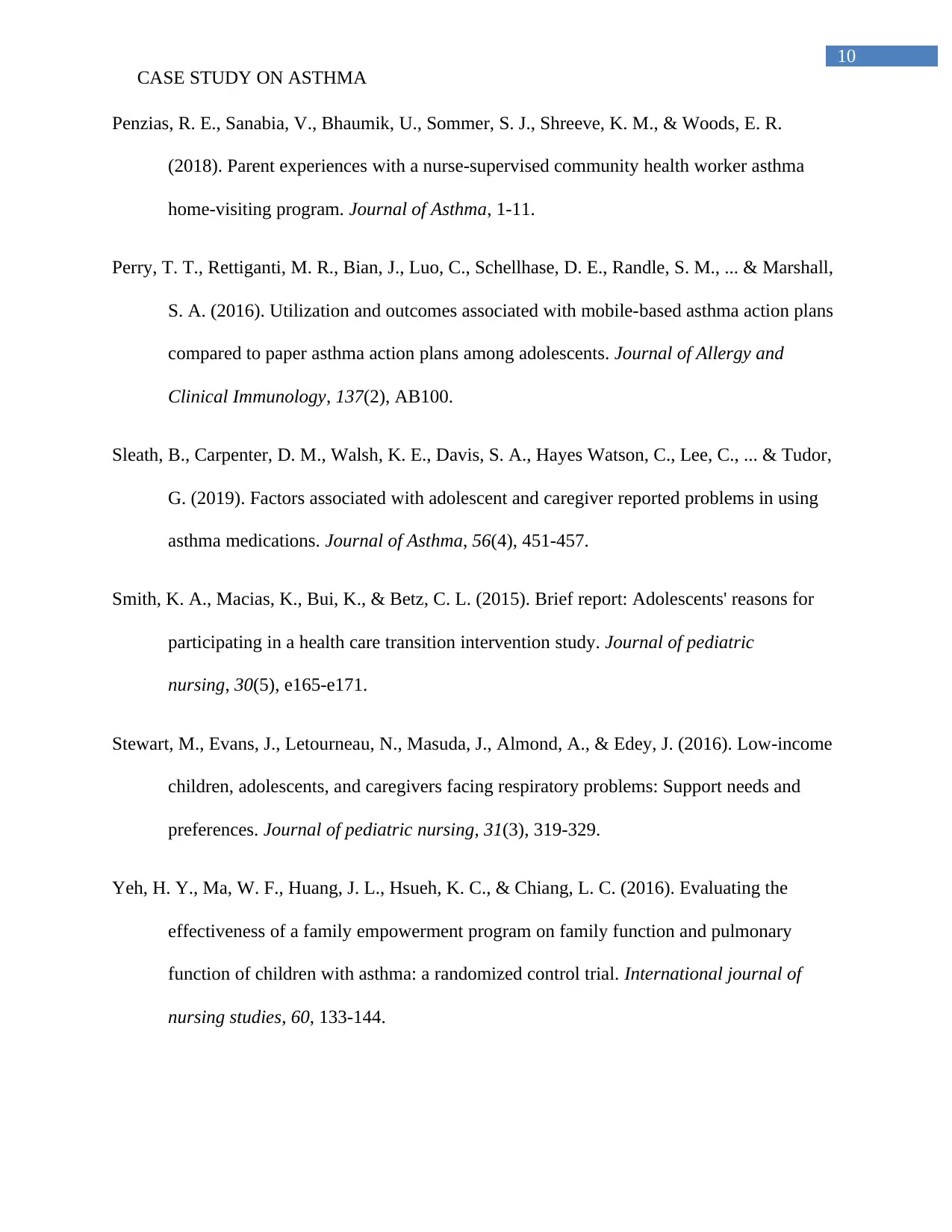
10
CASE STUDY ON ASTHMA
Penzias, R. E., Sanabia, V., Bhaumik, U., Sommer, S. J., Shreeve, K. M., & Woods, E. R.
(2018). Parent experiences with a nurse-supervised community health worker asthma
home-visiting program. Journal of Asthma, 1-11.
Perry, T. T., Rettiganti, M. R., Bian, J., Luo, C., Schellhase, D. E., Randle, S. M., ... & Marshall,
S. A. (2016). Utilization and outcomes associated with mobile-based asthma action plans
compared to paper asthma action plans among adolescents. Journal of Allergy and
Clinical Immunology, 137(2), AB100.
Sleath, B., Carpenter, D. M., Walsh, K. E., Davis, S. A., Hayes Watson, C., Lee, C., ... & Tudor,
G. (2019). Factors associated with adolescent and caregiver reported problems in using
asthma medications. Journal of Asthma, 56(4), 451-457.
Smith, K. A., Macias, K., Bui, K., & Betz, C. L. (2015). Brief report: Adolescents' reasons for
participating in a health care transition intervention study. Journal of pediatric
nursing, 30(5), e165-e171.
Stewart, M., Evans, J., Letourneau, N., Masuda, J., Almond, A., & Edey, J. (2016). Low-income
children, adolescents, and caregivers facing respiratory problems: Support needs and
preferences. Journal of pediatric nursing, 31(3), 319-329.
Yeh, H. Y., Ma, W. F., Huang, J. L., Hsueh, K. C., & Chiang, L. C. (2016). Evaluating the
effectiveness of a family empowerment program on family function and pulmonary
function of children with asthma: a randomized control trial. International journal of
nursing studies, 60, 133-144.
CASE STUDY ON ASTHMA
Penzias, R. E., Sanabia, V., Bhaumik, U., Sommer, S. J., Shreeve, K. M., & Woods, E. R.
(2018). Parent experiences with a nurse-supervised community health worker asthma
home-visiting program. Journal of Asthma, 1-11.
Perry, T. T., Rettiganti, M. R., Bian, J., Luo, C., Schellhase, D. E., Randle, S. M., ... & Marshall,
S. A. (2016). Utilization and outcomes associated with mobile-based asthma action plans
compared to paper asthma action plans among adolescents. Journal of Allergy and
Clinical Immunology, 137(2), AB100.
Sleath, B., Carpenter, D. M., Walsh, K. E., Davis, S. A., Hayes Watson, C., Lee, C., ... & Tudor,
G. (2019). Factors associated with adolescent and caregiver reported problems in using
asthma medications. Journal of Asthma, 56(4), 451-457.
Smith, K. A., Macias, K., Bui, K., & Betz, C. L. (2015). Brief report: Adolescents' reasons for
participating in a health care transition intervention study. Journal of pediatric
nursing, 30(5), e165-e171.
Stewart, M., Evans, J., Letourneau, N., Masuda, J., Almond, A., & Edey, J. (2016). Low-income
children, adolescents, and caregivers facing respiratory problems: Support needs and
preferences. Journal of pediatric nursing, 31(3), 319-329.
Yeh, H. Y., Ma, W. F., Huang, J. L., Hsueh, K. C., & Chiang, L. C. (2016). Evaluating the
effectiveness of a family empowerment program on family function and pulmonary
function of children with asthma: a randomized control trial. International journal of
nursing studies, 60, 133-144.

11
CASE STUDY ON ASTHMA
Yoo, W., Kim, S. Y., Hong, Y., Chih, M. Y., Shah, D. V., & Gustafson, D. H. (2015). Patient–
clinician mobile communication: analyzing text messaging between adolescents with
asthma and nurse case managers. TELEMEDICINE and e-HEALTH, 21(1), 62-69.
CASE STUDY ON ASTHMA
Yoo, W., Kim, S. Y., Hong, Y., Chih, M. Y., Shah, D. V., & Gustafson, D. H. (2015). Patient–
clinician mobile communication: analyzing text messaging between adolescents with
asthma and nurse case managers. TELEMEDICINE and e-HEALTH, 21(1), 62-69.
⊘ This is a preview!⊘
Do you want full access?
Subscribe today to unlock all pages.

Trusted by 1+ million students worldwide
1 out of 12
Related Documents
Your All-in-One AI-Powered Toolkit for Academic Success.
+13062052269
info@desklib.com
Available 24*7 on WhatsApp / Email
![[object Object]](/_next/static/media/star-bottom.7253800d.svg)
Unlock your academic potential
Copyright © 2020–2025 A2Z Services. All Rights Reserved. Developed and managed by ZUCOL.





